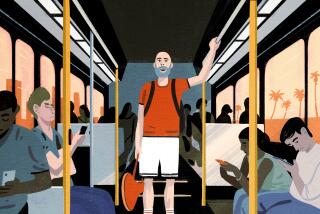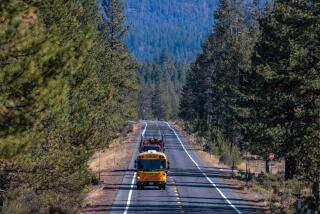Recapturing the magic of the bus
PLEASANT HILL, Ore. — Zane Kesey picks at clumps of moss and swirls of brightly colored paint and patches of rust covering the school bus that his father, the late author Ken Kesey, rode cross-country with a refrigerator stocked with LSD-laced drinks in pursuit of a new art form.
“This comes off pretty easy,” Kesey says, a smile playing over his face. “It’s amazing, some of the things that are coming out -- things I remember.”
He continues tidying the keepsake. “It’s going to take a lot of bubble gum,” he says.
For some 15 years, the 1939 International bus dubbed “Furthur” has rusted away in a swamp on the Kesey family’s Willamette Valley farm, out of sight if not out of mind, more memory than monument.
That is where Ken Kesey -- author of “One Flew Over the Cuckoo’s Nest” and hero of a generation that vowed to drop out and tune in with the help of LSD -- intended it to stay after firing up a new bus in 1990.
But four years after his death, a Hollywood restaurateur has persuaded the family to resurrect the old bus so it can help tell the story of Kesey, the Merry Pranksters and the 1960s.
“I read his books back in high school and through college,” says David Houston, owner of Barney’s Beanery in Los Angeles. “I just always thought he was a fascinating and brilliant man. The story of the bus was always very compelling.
“To find out it had been just left to go -- I really wanted to restore the bus and tell its story to the world.”
Houston hopes to raise the $100,000 he figures it will cost to get the bus running and looking good. The Kesey family will maintain control of the bus, taking it to special events.
“People think of a bus as transportation,” Zane Kesey says. “No. It’s a platform, a way to get your messages across.”
Last fall, a group of old Pranksters hauled the bus out of the swamp and parked it next to a barn to await restoration.
“One of the things that is really optimistic for me is it’s got full air in the tires from Cassady,” Kesey says, referring to Neal Cassady, who was the wheelman in Jack Kerouac’s “On the Road,” and drove Further on that first trip. “Honestly, if the tires had been flat, I would have said, ‘Just leave it there.’ ”
Symbol of counterculture
The restoration will be a tough job. On a cold misty day, Houston, Zane Kesey and former Green Turtle bus mechanic Mike Cobiskey climb on ladders, peer under the hood, pick at paint and crawl underneath.
What they see is daunting. The body is badly rusted. The paint is peeled. The roof leaks. The engine, not original, and transmission have been underwater. The original bunk beds and refrigerator are gone, but the driver’s seat remains.
“The most important thing is the paint,” Cobiskey says to Kesey. “I’m sure you have a thousand pictures of it.”
“And no two are alike,” Kesey replies.
“It’s gonna go,” Houston says. “It can definitely run. It shouldn’t drive across country. But certainly it should be a living, healthy, valuable piece once we are done with it.”
Bob Santelli, artistic director of the Experience Music Project in Seattle, tried to raise money to restore Further in 1996 when he was at the Rock and Roll Hall of Fame and Museum in Cleveland, but couldn’t swing it. He did get Kesey to bring the newer incarnation to the museum.
“I consider the bus to be one of the most important icons of the ‘60s counterculture,” Santelli says. “Inside that bus occurred many of the things the counterculture was all about, from a revolutionary perspective. That is mobility, freedom to be on the move, and to react to situations and create situations to react to, drug use and experimenting with drugs, and the importance of music in a cultural revolution.”
Acid tests
Fresh from the success of “Cuckoo’s Nest,” Ken Kesey wanted to drive to New York City for the 1964 World’s Fair and a coming-out party for his new book, “Sometimes a Great Notion,” making a movie along the way.
“At first, a bunch of us were going to go in a station wagon,” says Ken Babbs, one of the original Pranksters. “Then it was getting too big for that.”
Kesey bought the bus in Atherton, Calif., for $1,250 from Andre Hobson, a sales engineer who had outfitted it with bunks, a bathroom and a kitchen to take his 11 kids on vacation.
Hobson, who never saw the bus again, says he had no idea who Kesey was. “But I do know his check was good,” he says.
At La Honda, Kesey’s home in the Santa Cruz Mountains south of San Francisco, they installed a sound system and a generator. Artist Roy Sebern painted “Furthur” on the destination placard as a kind of one-word poem. It wasn’t until much later that he found out he had misspelled it. Later the Further sign was corrected.
The wildly painted bus got stopped by the police, but with their short haircuts and preppy clothes, the Pranksters were never arrested. They carried orange juice laced with LSD, which was legal at the time. Kesey had been a guinea pig in government-sponsored LSD tests and was trying to turn the entire country on to it through events known as the “Acid Tests.”
As they rolled through New York City, the Pranksters tootled saxophones and blew soap bubbles from the roof, and later stopped at Timothy Leary’s Millbrook meditation center in upstate New York.
The film and tape rolled constantly, but when they got back to La Honda, they could never get the two to synchronize. Author Tom Wolfe used the material for his book, “The Electric Kool-Aid Acid Test,” but the movie lay dormant until 2000, when a digital editing machine made it possible.
“When people ask what my best work is, it’s the bus,” Ken Kesey said in 2000. “Those books made it possible for the bus to become.”
After one last trip, to Woodstock, N.Y., in 1969, Kesey put the bus out to pasture, where it served as a dugout for softball games. The Smithsonian Institution in Washington, D.C., expressed some interest in restoring the bus, but Kesey would never let it go. He towed it to the swamp in 1990 when he bought a 1947 bus for a new series of trips.
“People were always saying, ‘Is this the real bus?’ ” Babbs says. “And he would say, ‘Yes, there’s only one bus, just like there’s only one Starship Enterprise.’ ”
More to Read
Sign up for The Wild
We’ll help you find the best places to hike, bike and run, as well as the perfect silent spots for meditation and yoga.
You may occasionally receive promotional content from the Los Angeles Times.






